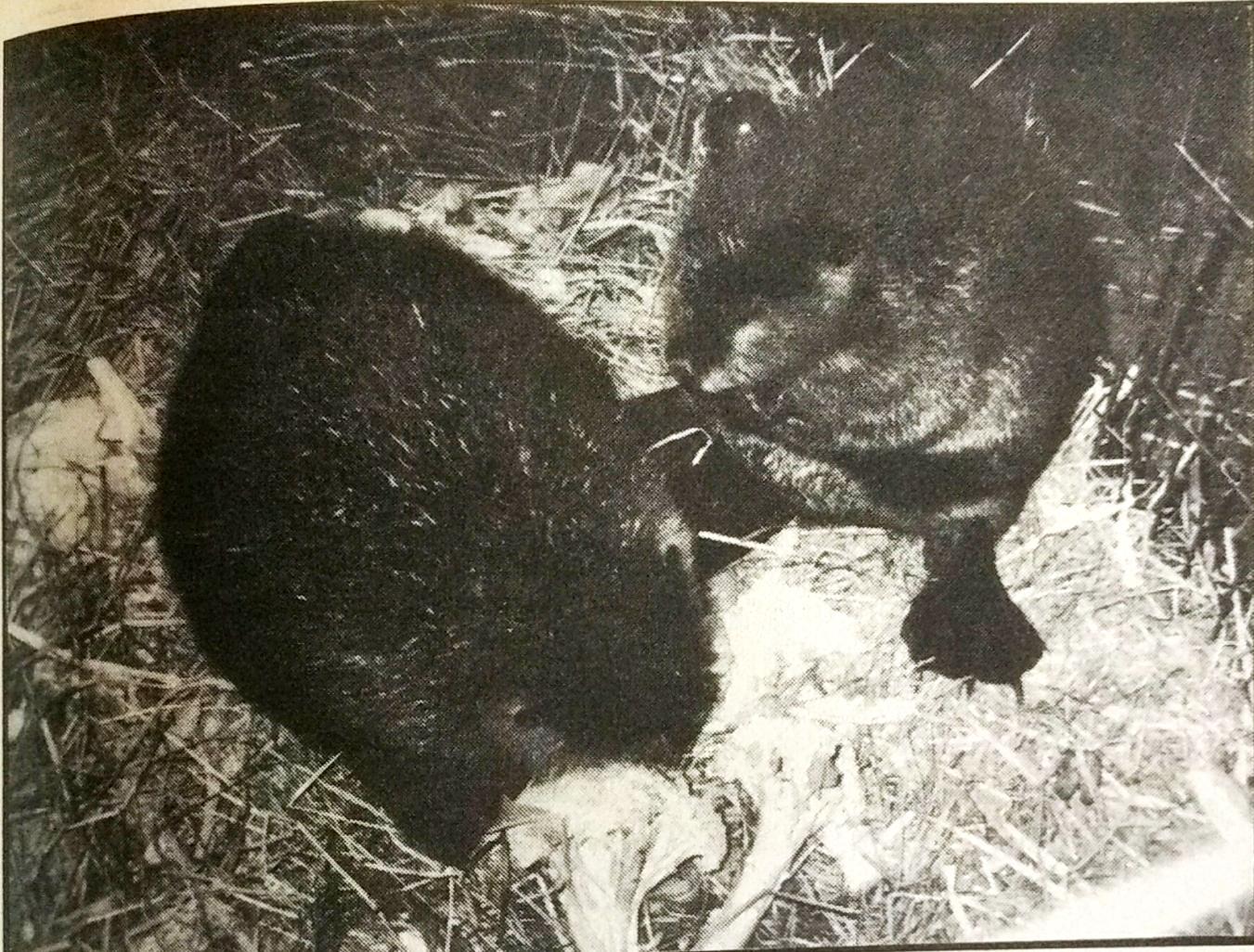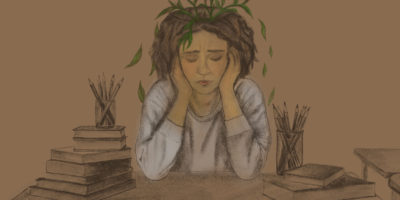By Dave Cameron
On a crisp February day, Audrey Tournay tends the animals on her Muskoka lot. In a grungy brown parka, worn mitts and rubber boots, Tournay fits the farmer’s mold. But although there’s a wood-panelled house and an aging labrador retriever running about, this acreage in Rosseau, Ontario, near Parry Sound, is no ordinary farm. It’s a temporary shelter and hospital for wild animals. The Aspen Valley Wildlife Sanctuary is Tournay’s refuge for injured, abused or otherwise needy animals. Coyotes, wolves, raccoons and bears are some of the creatures that share Tournay’s land.
Tournay bends down at the door of a cage beside the barn. An orange fox hurries over, its thick feather-duster tail shaking excitedly. “We’re going to build you a nice big pen in the spring, aren’t we?” Tournay says to the fox. “Oh, she says, I might not last until spring unless you feed me,” she answers for the animal. The fox had been somebody’s pet and was kept in a rabbit cage, arriving at Aspen Valley unable to stretch up on four legs.
Tournay inspects another spacious pen, where eight coyote pups race around, and puts her heartfelt faith into words. “We do all that can be done to fight against death in humans, why shouldn’t we be the same for animals?” she asks. Tournay believes that protecting wildlife means protecting it from humans. She says that her sanctuary wouldn’t be necessary if animals weren’t getting shot or having their homes destroyed by human activity. “Ninety per cent of the animals that are here are here because of human interference,” she says.
Tournay moves to the area from St. Carharines in 1969, bringing with her a devout appreciation of the natural world and its creatures. She can’t trace her passion, and finds her profound love of animals somewhat of an enigma. Her care and beliefs were not shared b her hunting family — she is the daughter of an avid rifleman.
Tournay was a high school teacher for 30 years. In 1969, a conservative officer dropped off a sick baby raccoon and Tournay nursed it back to health. It became apparent to her that a place was needed to care for injured or displaced wildlife. She moved to Rosseau in 1972 and worked another nine years in Parry Sound before retiring to address the growing number of animals at the sanctuary and spread her message of wildlife protection.
Tournay, now 67 and admittedly getting tired, operates the sanctuary with a paid staff of one and many volunteers, young and old, from the area. With an annual budget of over $70,000 (to raise a single bear cub costs $1,000), funding is a continuing concern. Most of the money comes from private donations and a yearly newsletter with over 900 subscribers. Stores in Parry Sound donate fruit, vegetables and, for the wolves, out-dated meats. Most of the animals are taken to remote areas in elsewhere in Ontario after they’re nursed back to health.
A bright red sign hands on the door of a shed near the barn. In thick black marker, the poster reads: “OFF LIMITS—Consider: The cubs have seen their mothers killed and have starved for up to two weeks. They don’t need more stress — please understand.” The goal is to minimize human contact with the cubs before they are released. Tournay says that about 100 people go through the sanctuary each visiting day.
Tournay leads me on a brief tour of the shed. Most of the enclosures appear empty except for sections of large, hollowed logs and piles of grass and hay. The logs are a winter home for 13 of Aspen Valley’s cubs. We slip quietly from the shed back into the wind.
Many of the bears referred to Tournay end up at Bear With Us, an offshoot sanctuary of Aspen Valley that specializes in bear rehabilitation. Operated by Mike McIntosh in Sprucedale, Bear With Us cares for injured bears and orphaned cubs.
It was a busy year for bear rehabilitation. Aspen Valley and Bear With Us nursed a total of 37 orphaned bear cubs. And, according to McIntoch, beyond having a tough time finding adequate food, bears clash with humans while sharing cottage country. “A bear minding his own business has a hard time roaming its natural territory without stumbling into somebody,” he says.
Norine Hawkshaw is one member of a diverse supporting cast for Tournay and Aspen Valley. She operates Hawkshaw’s Wildlife Sanctuary in Sprucedale, rehabilitating raccoons and other small animals that can’t be accommodated at Aspen Valley. She tells a tale that would make any conservationist cringe. Three years ago, Hawkshaw was feeding many of the animals out in an open field. This attracted a group of black bears, who found the food readily available. Hawkshaw says she had to continue to provide meals as the smaller animals were dependent on the feedings. It was not long before word spread in the community that nine black bears could be found on Hawkshaw’s 69 acres. In the spring, eight of the nine bears were killed by hunters while Hawkshaw and her husband were away. For Tournay, hunting and other human activities are unnecessary interference. “Manmade tragedies are not nature taking its course,” she says.
Animal rehabilitation, however, is not without its share of debate. Jan McDonnell is a wildlife biologist with the Ministry of Natural Resources in Bracebridge. Missionaries like Tournay face opposition from those who argue that only the total animal population should be of any concern. “Some people think that animal rehabilitation doesn’t make any difference biologically, that we should be putting priority into the habitat of the animal and the individual animal doesn’t matter,” McDonnell says. “That’s the way nature works.” From this viewpoint, she says, rehabilitators aren’t necessary.
However, according to Donna Dubreuil, most rehabilitators are under no illusions about whether or not they affect animal populations. Dubreuil, associate director of the Ottawa-Carleton Wildlife Centre, believes it is simply a matter of a moral duty. “It is our responsibility to deal with individual animals in need, especially those who have been compromised by humans,” she says.
“And populations, after all, are made up of individuals. A lot of rehabilitators want to play Dr. Wildlife,” she says. “But there’s a spiritual quality to why Audrey does it.”
We head to Tournay’s house. Her home is a cramped jungle of pottery, wood carvings and hanging plants. Downstairs, a pair of ten-month-old beaver kits are sharing a pen for the winter. The beavers drop their apples and broccoli and plead for our attention with constant whining. Tournay puts her hand in to let one of them rub its large brown teeth against her fingers. “There’s no average day around here,” she says. She quickly soothes the two animals like a mother, offering a thumb to a teething infant. Orphaned when a road was paved through their swamp, the beaver will be released to a nearby pond in the spring.
“Another beaver may be arriving this week from Barrie,” says Tournay. “The lady that called said a beaver came out of her pong during the last that and it was so starved that she could reach down and pick it up. She wanted to know if I would take it and I said, ‘Oh yes.’” Yes is the only answer Tournay will give when an animal is in need.










Leave a Reply